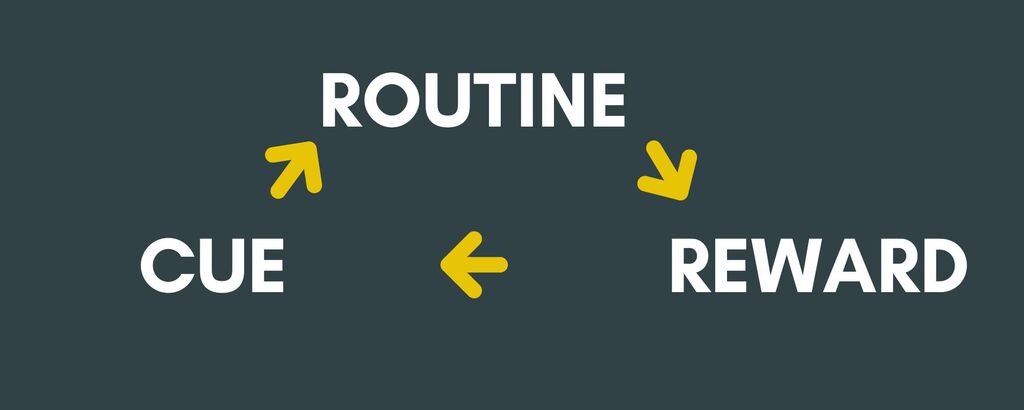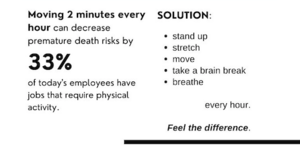Brain fog, body stiffness, and cardiovascular diseases: these are some of the consequences of not moving your body regularly enough. Everyone knows that physical activity is necessary for the body and the mind to function correctly. Still, research from the US Department of Health and Human Services shows that 80% of US adults and adolescents are insufficiently active.
One of the biggest reasons for this is work.
Over the course of a lifetime, the average person works more than 3,500 days. Most people, especially those who work in the office, spend a good chunk of that time seated at a desk. This is detrimental to the workforce’s health and increases the risk of type 2 diabetes, cancer, and heart disease.
There are many benefits to introducing micro-breaks at work. It can improve the employee experience and work output while also impacting their personal health positively. This article talks about how to introduce movement, active breaks, and brain breaks in the workplace for a healthy and well workforce.
Do people move enough?
As you will soon see, physical inactivity is now a global issue.
Nowadays, the majority of individuals lead sedentary lives, spending most of their waking hours (apart from the occasional bathroom or coffee breaks) sitting down. People sit in their cars or on public transport while commuting to work.
There’s also the 2.8 hours of TV that the average person sits to watch each day. Plus, the majority of office workers have their lunch at their workstations, which results in even less time spent up and about.

Movement, and the Psychology of Habit Forming
The importance of movement, especially in the workplace, cannot be overemphasized.
If you can incorporate some combination of mental stimulation, physical activity, and social engagement into your work day or that of your workers, you will see more team engagements and achieve wellness in the workplace.
But cultivating a habit of movement during office work isn’t as easy as it sounds. To get the benefits of short breaks during working hours, you need to use the psychology of habit forming. 40% of people’s acts are habitual rather than intentional choices.
Therefore, habits play a significant role in your employee’s lives, even though they aren’t often aware of it.
Ivan Pavlov, a Russian physiologist, made a discovery over a century ago that has persisted in both psychological research and popular culture. According to classical conditioning or Pavlovian conditioning, repeatedly associating a motivating stimulus (like food) with a specific signal (like a ringing bell) will cause a conditioned response when the signal is encountered.
Therefore, the ringing of a bell will cause a behavioral response like salivation. As a result of Pavlov’s repeated coupling of the food with the ringing bell, his dogs began to salivate at the sound of the bell alone.
Every habit is fundamentally driven by this brain process.
Here is a straightforward but effective three-step loop that manages how we create habits.

- Cues: these are like triggers for your brain – they tell it which habit to use and when to use it.
- Routines: these are the activities, emotions or behaviors that make up a habit.
- Rewards: these are how your brain decides if a loop is worth continuing or not. Rewards are important because they reinforce the behavior that preceded it, making it more likely that you’ll do it again in the future.
- Cue – You get to work.
- Routine – You sit at your desk and start working.
- Reward – You feel relaxed and get work done.
The cue and the reward have a significant impact on developing habits. These are the factors that cause cravings and make you repeat behaviors.
So, if you sit all the time, this seemingly harmless activity could make you addicted to a sedentary lifestyle and lead to all kinds of health hazards.
What would you have to do if you wanted to break that habit?
Bad habits, particularly those involving addiction, can be challenging to quit since they are frequently connected to particular settings or rituals. This means that in addition to dealing with the addiction itself, you also need to eliminate the link between the addiction and the triggers. If you wish to break the habit of sitting for too long, here’s how to go about it.
- First, introduce some form of exercise to break prolonged sitting. Exercise produces physiological change in a manner that other things would not, making it effective.
- Repeat tomorrow, the day after tomorrow, every day during the next month. For example, stand up every 60 minutes for 30 minutes, stretch shortly, walk.
- Finally, if you want to build a habit, it’s important to do two things: regularly decide to practise the behavior, and actually practise it. To help make sure your new habit sticks, do it consistently everyday. Try using habit stacking and incremental changes to max out your motivation.
The benefits of active and brain breaks
An active or movement break is a brief interval of relaxing and stretching exercises, during work hours. It is advised to perform these breaks every two working hours. They typically lasts for around 1-15 minutes. This procedure makes it easier for employees to release pent-up stress from their duties and take a break to revitalize their bodies.
No matter how ergonomic it is, a workstation cannot support your posture and health if you sit for too long. If you introduce little bursts of exercises at different points during work, you’ll get the full benefits from your ergonomic setup.
Also, note that a movement break can’t replace weekly sports sessions, neither can weekly sports sessions replace movement breaks.
Why?
Because active breaks are too short to give your body the necessary health benefits that exercise are meant to give. At the same time, if you don’t move regularly during the 7-10 hours of work, no longer exercise session will be able to fix your posture and keep your body alert while working.
What are brain breaks?
A brain break is any activity that provides a break from sustained mental labor: allowing the brain and body to rest and replenish resources that are depleted while working.
Taking brain breaks throughout the day to replenish these resources has been found to help the mind unwind. It allows our emotional energy to recharge so that we feel better throughout the day.

It also helps to renew our cognitive resources so that we can do deep work and be more productive. Additionally, it has been demonstrated to generally result in a better night’s sleep, which lowers the risk of burnout.
Mindful breaks like this help you focus on the right tasks and projects by stepping back and reassessing your objectives and priorities. For managers, it’s especially important to be able to see the big picture and avoid getting bogged down in process-driven tasks that could be delegated to other team members.
Having this broad perspective can help you keep your attention on strategic objectives and make better decisions with a clear mind.
In actuality, sitting is not really what harms us. The real detriments are prolonged durations of sitting with poor posture, minimal activity, and few breaks for standing or walking. It’s, therefore, crucial to sit with excellent posture but still get up and move about sometimes.
Your office space can be planned to encourage mobility all day long. Including an adjustable desk in your office is one simple way. With this, a user may position their keyboard and monitor at comfortable working heights, standing or seated. The desk has the benefit of adjustability, which is useful for users in shared workspaces, especially if they have different heights.
You can also minimize in-office emails so employees are forced to walk to their co-workers when they want to pass a message.
Here’s a further breakdown of how to practice active breaks:

Standing and walking
It is advised that computer users switch positions every 30 minutes. For instance, sit for 20 minutes, stand up and work for 8 minutes, then move around for 2 minutes.
This promotes metabolism, increases blood flow, and naturally aligns your spine. Additionally, make it a practice to stand if you are reading, participating in a conference call or webinar, or talking to a coworker on the phone.
Desk-side stretching
On a typical workday, you need to stretch everywhere from your shoulders and neck, to your back, wrists and hips.
Repeat multiple times during your work hours. If you’re familiar with active sitting, you could even do most of these while still seated.
Make sure to move your spine in the 3 planes of motion.
This involves:
- flexion/extension= bending forward and backward
- side bend
- rotation
Tip: If you need to, feel free to use your desk or chair as props. Office yoga and desk-side stretching is particularly designed for an office environment and can be done in your regular office attire.
In a Nutshell
As executive, manager, team leader, encourage encourage workforce to become more active while working hours. This can take place in form of a walking meetings.
Walking meetings are particularly helpful in 1:1 meetings between HR managers and their staff members during a less formal check-in. With all these in place, the workforce will experience more wellness and productivity at work.
At Balance & Core, we help companies employee well-being through tailored wellness solutions. These involve educational seminars, movement sessions and relaxation techniques.
Improving employees’ posture is an essential pillar of our corporate programs. We guide you in making little changes to your working environment that can make a huge wellness difference.
Contact us today and let’s discuss your company’s wellness needs!



